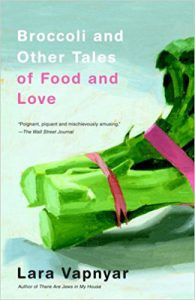Broccoli and Other Tales of Food and Love, by Laura Vapnyar
Broccoli and Other Tales of Food and Love
By Laura Vapnyar
Anchor Books
Three stars
Reviewed by Jessica Gribble
You might choose this book, as I did, because you love food, love, or broccoli. It turned out, though, that the most important thing is to like Russian literature. These six short stories all feature Russian immigrants to the United States who eat together. The character’s lives are uniformly depressing with occasional moments of joy—the joy is often connected with food. Lara Vapnyar’s sentences are short and somehow very Russian: sad and matter-of-fact. Nothing much happens in each story. If you prefer dramatic action to conversation and feelings, this is not the book for you. However, readers who like Russian novels will likely enjoy it. Vapnyar’s characters run the gamut of ages and body types, which is a refreshing change from glittery summer reading.
A brief summary of six stories: Nina’s husband, a talented musician, leaves her. She’s alone with the fresh vegetables she always buys but never cooks until she meets a man who loves to cook and finds a touch of redemption. Sergey goes to a prostitute, to his shame, but sees the wife and mother in her as she makes him borscht. Katya discovers her own beauty and shares the excitement of American puffed rice with a friend on the same day, but is disappointed by both in the end. Tanya’s mother is desperate to find her a suitor, but the one she finds herself becomes part of her family, which she slowly accepts. Luda and Milena fight over an eligible bachelor in their ESL class, with meatballs their weapon of choice. And Ružena makes up a fiancé whose—even false—existence gives her the courage to stop eating spinach.
One thing Vapnyar does well is describe food so that the reader can not only see it, but practically taste it: “And then the hot borscht was in their plates. Steaming, bursting with colors. All shades of red in perfect harmony with the faded purple of beets, the deep orange of fat rings, the white of sour cream in the middle, and the dark green of parsley bits.”
I was delighted that the book came with recipes at the end. I had fresh beets from the garden and couldn’t wait to try a traditional borscht recipe. However, I found the chatty, intimate style of the narrative surrounding the recipes a bit off-putting. The lightness seemed frivolous in contrast with the tenor of the stories. While it was interesting to learn about Vapnyar, I was slightly offended by her determination that Americans won’t eat traditional Russian food. She spends too much time explaining that the food is fatty and not good for me, but delicious. If it’s delicious, perfect! Never mind the nutrition information. It’s a book of short stories with matching recipes; I definitely want the appropriate recipes. I made the hot borscht, which has a beef stock, and found it heavy and greasy. I ended up pouring out the liquid and eating it as a stew. The cold borscht starts with store-bought borscht, which seems strange. The spinach recipe is for cold spinach salad—even though the final story is called “Slicing Sautéed Spinach.” However, the salad Olivier sounds delicious and hearty, and is presented in three versions: plebian, aristocratic, and “something-Americans-might-eat.”
All in all, I was mildly disappointed by both the stories and the recipes. But it’s a quick read and you may like both the characters and the food more than I did. I suspect that people with Russian heritage will find a few nostalgic or at least familiar thoughts and foods inside, and the downtrodden characters do have their moments of charm.
